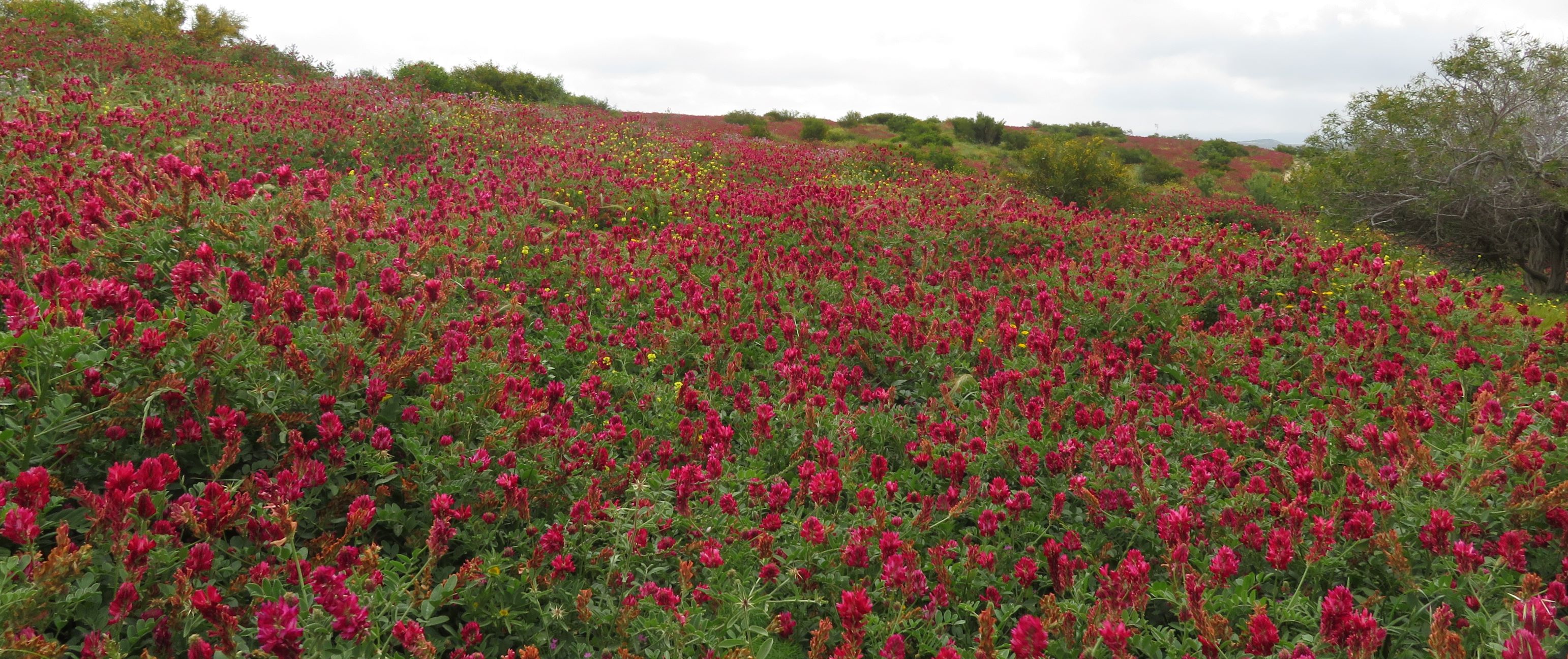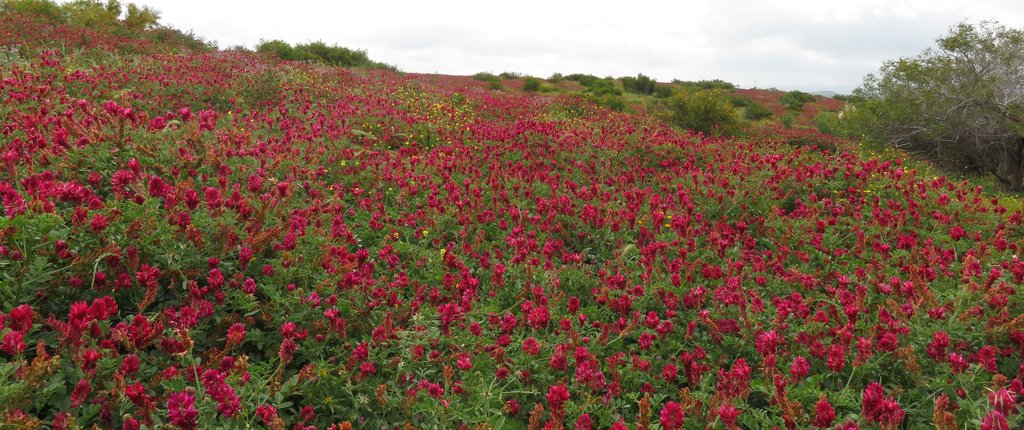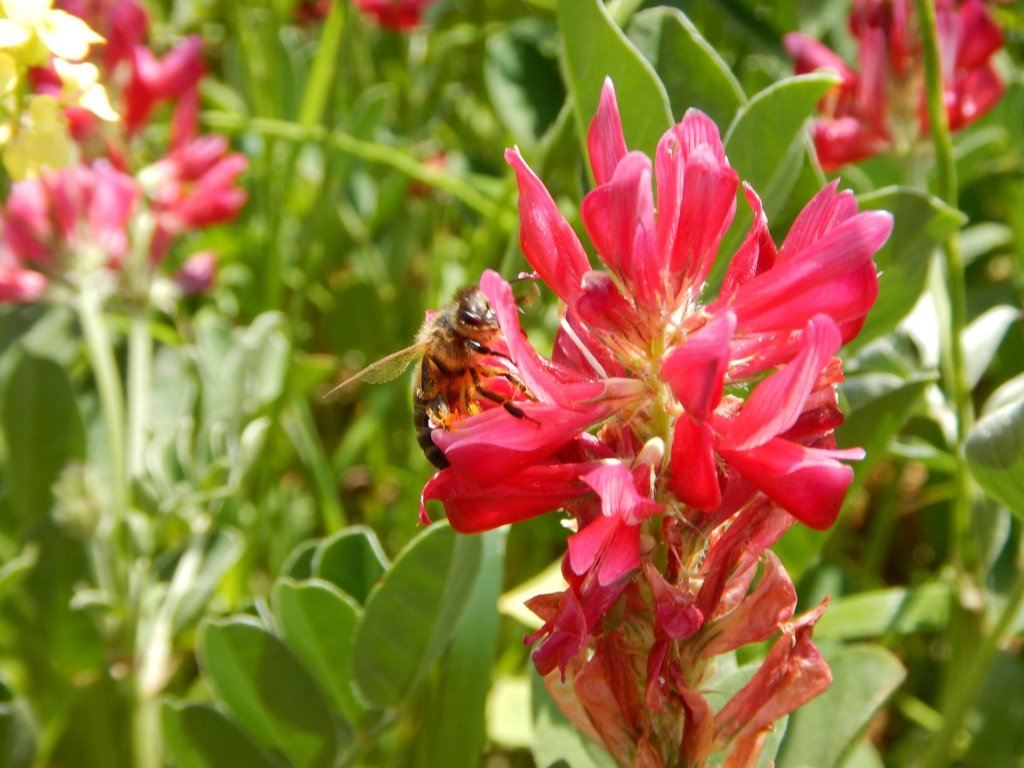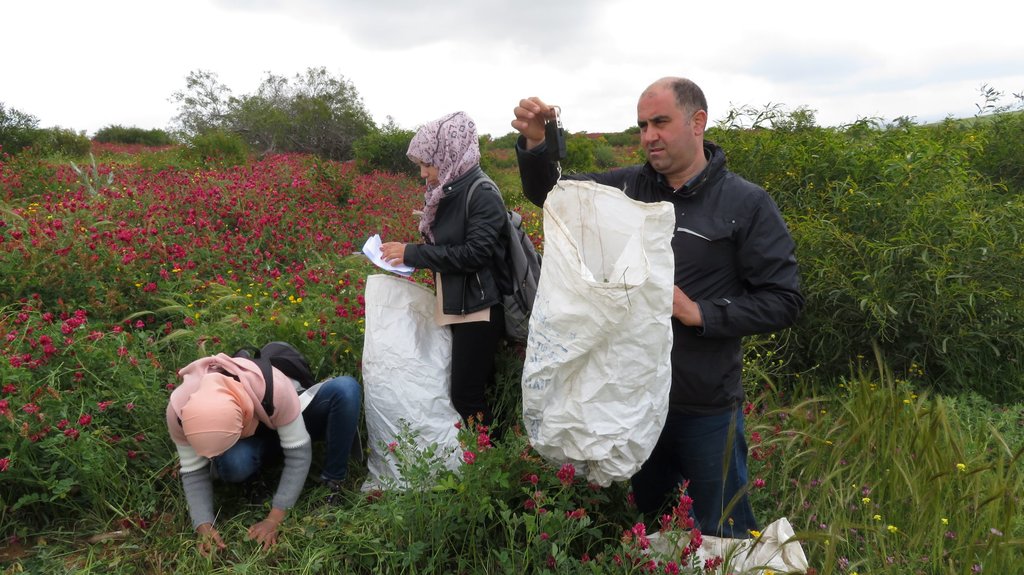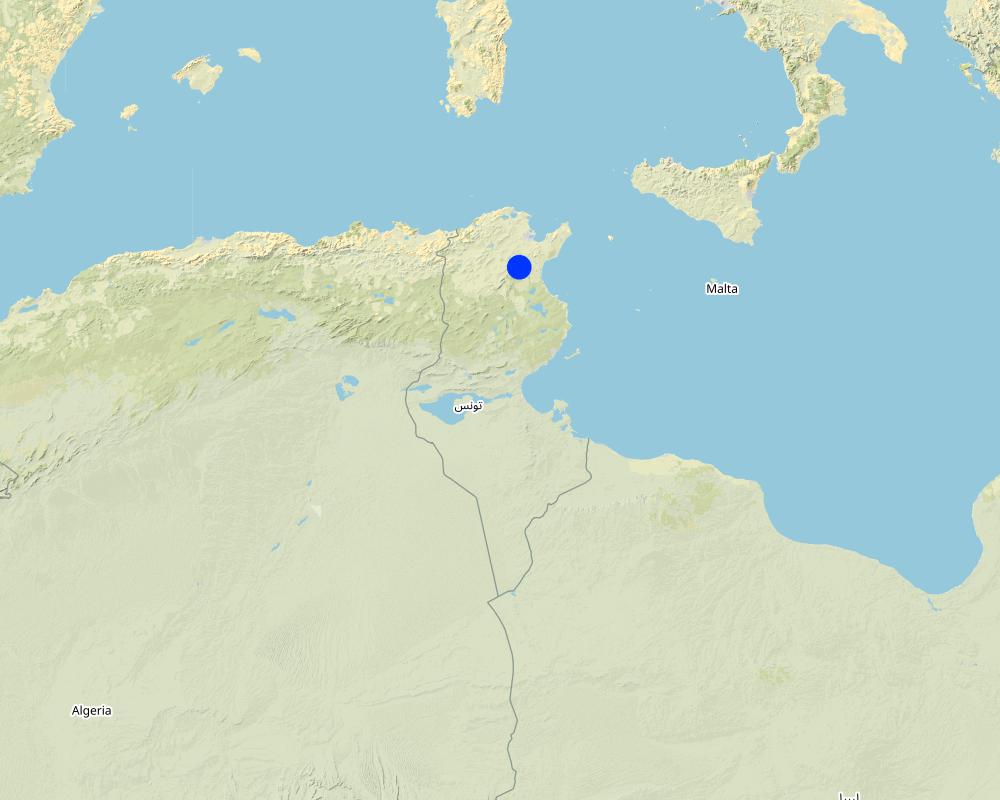Native Drought-Tolerant Forage Species for Enhanced Dryland Pasture Restoration [Tunisia]
- Creation:
- Update:
- Compiler: Joren Verbist
- Editor: –
- Reviewers: Rima Mekdaschi Studer, William Critchley
technologies_5919 - Tunisia
View sections
Expand all Collapse all1. General information
1.2 Contact details of resource persons and institutions involved in the assessment and documentation of the Technology
Key resource person(s)
Research Team Leader of Rangeland Ecology and Forages:
Louhaichi Mounir
International Center of Agriculture Research in the Dry Areas (ICARDA)
Jordan
Associate Professor:
Slim Slim
School of Higher Education in Agriculture of Mateur
Tunisia
Name of project which facilitated the documentation/ evaluation of the Technology (if relevant)
ICARDA Institutional Knowledge Management InitiativeName of the institution(s) which facilitated the documentation/ evaluation of the Technology (if relevant)
International Center for Agricultural Research in the Dry Areas (ICARDA) - Lebanon1.3 Conditions regarding the use of data documented through WOCAT
The compiler and key resource person(s) accept the conditions regarding the use of data documented through WOCAT:
Ja
1.4 Declaration on sustainability of the described Technology
Is the Technology described here problematic with regard to land degradation, so that it cannot be declared a sustainable land management technology?
Nee
2. Description of the SLM Technology
2.1 Short description of the Technology
Definition of the Technology:
The technology utilizes a drought-tolerant native forage legume, Hedysarium coronarium, to restore degraded soils by covering the soil, fixing nitrogen, improving biodiversity and increasing water infiltration while fodder quality and availability is improved.
2.2 Detailed description of the Technology
Description:
In the semi-arid areas of Tunisia, drylands are prone to a harsh environment combining high temperatures and limited annual rainfall (350 - 600mm). Nevertheless, many marginal farmers depend on these drylands for income through grazing their livestock. However, due to worsening climatic conditions and mismanagement, the land is becoming seriously degraded. This results in a degradation cycle: overgrazing results in less land available to graze and therefore more rapid degradation on those areas. To break the cycle, an innovative approach is needed.
The International Centre of Agricultural Research in Dry Areas (ICARDA) recognized the problem and developed an approach, together with national parties Office de l'élevage et des pâturages (OEP), Office du Développement Sylvo- Pastoral du Nord -Ouest (ODESYPANO), and Direction Générale des forêts (DGF). They focused on native species which are adapted to the harsh environmental conditions. They selected leguminous species, because these enhance the soil's nutrient status through nitrogen fixation. Additionally, legumes improve the diet of livestock. The perennial Hedysarum coronarium or "Sulla" provides the soil with cover, reducing erosion and increasing water infiltration: rainfall is intercepted by the vegetation cover, resulting in less runoff. The cover also provides shade, which decreases evaporation. Then, the roots of the vegetation improve soil porosity, hence the infiltration capability of the soil. All these benefits improve biophysical and socio-economic resilience.
A degraded field was planted with Sulla in 2017. The land was ploughed before manual seeding. To prevent overgrazing, grazing was managed according to guidelines formulated by ICARDA and national parties. In the initial year, twenty-five smallstock (sheep/goats) graze one hectare for thirty to sixty days. In subsequent years, forty smallstock graze one hectare for thirty to sixty days, since the vegetation is then better rooted and developed. To maintain optimal production, a field needs reseeding after three years, hence the activities and related costs shown in this documentation are recurrent every three years.
This technology has had several positive impacts in the area. The productivity was increased from approximately 2310 kg (dry matter: DM) per hectare to approximately 5330 DM kg per hectare. The technology also increased water productivity from 9.5 DM kg per mm rainfall to 11.8 DM kg per mm rainfall. Hedysarum coronarium improved the quality of fodder, thus benefiting local land users. In addition, the soil was less prone to erosion and water better retained in the soil.
Land users also stated that they benefited from the improved fodder availability because this decreased the costs of feed import. Also, since Sulla is suited to the local climate, few inputs are required, reducing costs and work.
2.3 Photos of the Technology
2.5 Country/ region/ locations where the Technology has been applied and which are covered by this assessment
Country:
Tunisia
Region/ State/ Province:
Zaghouan Governorate
Specify the spread of the Technology:
- evenly spread over an area
If precise area is not known, indicate approximate area covered:
- < 0.1 km2 (10 ha)
Is/are the technology site(s) located in a permanently protected area?
Nee
Map
×2.6 Date of implementation
Indicate year of implementation:
2017
2.7 Introduction of the Technology
Specify how the Technology was introduced:
- during experiments/ research
- through projects/ external interventions
3. Classification of the SLM Technology
3.1 Main purpose(s) of the Technology
- improve production
- reduce, prevent, restore land degradation
- reduce risk of disasters
- adapt to climate change/ extremes and its impacts
- create beneficial economic impact
3.2 Current land use type(s) where the Technology is applied
Land use mixed within the same land unit:
Nee

Cropland
- Perennial (non-woody) cropping
- Hedysarum coronarium "Sulla"
Number of growing seasons per year:
- 1
Is intercropping practiced?
Nee
Is crop rotation practiced?
Nee

Grazing land
Extensive grazing:
- Semi-nomadic pastoralism
Animal type:
- goats
- sheep
Is integrated crop-livestock management practiced?
Nee
Species:
sheep
Species:
goats
3.3 Has land use changed due to the implementation of the Technology?
Has land use changed due to the implementation of the Technology?
- Yes (Please fill out the questions below with regard to the land use before implementation of the Technology)

Unproductive land
Specify:
Degraded lands
3.4 Water supply
Water supply for the land on which the Technology is applied:
- rainfed
3.5 SLM group to which the Technology belongs
- pastoralism and grazing land management
- improved ground/ vegetation cover
- improved plant varieties/ animal breeds
3.6 SLM measures comprising the Technology

agronomic measures
- A1: Vegetation/ soil cover
- A5: Seed management, improved varieties

vegetative measures
- V2: Grasses and perennial herbaceous plants

management measures
- M2: Change of management/ intensity level
3.7 Main types of land degradation addressed by the Technology

soil erosion by water
- Wt: loss of topsoil/ surface erosion
- Wg: gully erosion/ gullying

soil erosion by wind
- Et: loss of topsoil
- Ed: deflation and deposition

chemical soil deterioration
- Cn: fertility decline and reduced organic matter content (not caused by erosion)
- Cs: salinization/ alkalinization

physical soil deterioration
- Pk: slaking and crusting
- Pi: soil sealing

biological degradation
- Bc: reduction of vegetation cover
3.8 Prevention, reduction, or restoration of land degradation
Specify the goal of the Technology with regard to land degradation:
- reduce land degradation
- restore/ rehabilitate severely degraded land
4. Technical specifications, implementation activities, inputs, and costs
4.1 Technical drawing of the Technology
Technical specifications (related to technical drawing):
The average plant density is 120 per square metre. This relates to the following spacing:
Space within rows (A) = 9 centimeter
Space between rows (B) = 9 centimeter
Author:
Joren Verbist
Date:
07/07/2021
4.2 General information regarding the calculation of inputs and costs
Specify how costs and inputs were calculated:
- per Technology area
Indicate size and area unit:
1 Hectare
Specify currency used for cost calculations:
- USD
Indicate average wage cost of hired labour per day:
7
4.3 Establishment activities
| Activity | Timing (season) | |
|---|---|---|
| 1. | Land Preparation | |
| 2. | Seeding |
4.4 Costs and inputs needed for establishment
| Specify input | Unit | Quantity | Costs per Unit | Total costs per input | % of costs borne by land users | |
|---|---|---|---|---|---|---|
| Labour | Manual Seeding | Person-Hours | 10.0 | 0.875 | 8.75 | 100.0 |
| Equipment | Plough | Machine-Hours | 0.75 | 15.0 | 11.25 | 100.0 |
| Plant material | Sulla Seed | Kilogram | 30.0 | 1.5 | 45.0 | |
| Total costs for establishment of the Technology | 65.0 | |||||
| Total costs for establishment of the Technology in USD | 65.0 | |||||
If land user bore less than 100% of costs, indicate who covered the remaining costs:
The seeds are often provided by other parties such as ICARDA or national parties
Comments:
The activities and related costs are recurrent every 3 years.
5. Natural and human environment
5.1 Climate
Annual rainfall
- < 250 mm
- 251-500 mm
- 501-750 mm
- 751-1,000 mm
- 1,001-1,500 mm
- 1,501-2,000 mm
- 2,001-3,000 mm
- 3,001-4,000 mm
- > 4,000 mm
Agro-climatic zone
- semi-arid
5.2 Topography
Slopes on average:
- flat (0-2%)
- gentle (3-5%)
- moderate (6-10%)
- rolling (11-15%)
- hilly (16-30%)
- steep (31-60%)
- very steep (>60%)
Landforms:
- plateau/plains
- ridges
- mountain slopes
- hill slopes
- footslopes
- valley floors
Altitudinal zone:
- 0-100 m a.s.l.
- 101-500 m a.s.l.
- 501-1,000 m a.s.l.
- 1,001-1,500 m a.s.l.
- 1,501-2,000 m a.s.l.
- 2,001-2,500 m a.s.l.
- 2,501-3,000 m a.s.l.
- 3,001-4,000 m a.s.l.
- > 4,000 m a.s.l.
Indicate if the Technology is specifically applied in:
- not relevant
5.3 Soils
Soil depth on average:
- very shallow (0-20 cm)
- shallow (21-50 cm)
- moderately deep (51-80 cm)
- deep (81-120 cm)
- very deep (> 120 cm)
Soil texture (topsoil):
- medium (loamy, silty)
Soil texture (> 20 cm below surface):
- medium (loamy, silty)
Topsoil organic matter:
- medium (1-3%)
If available, attach full soil description or specify the available information, e.g. soil type, soil PH/ acidity, Cation Exchange Capacity, nitrogen, salinity etc.
(47% silt, 29% sand and 24% clay)
5.4 Water availability and quality
Ground water table:
5-50 m
Availability of surface water:
poor/ none
Water quality (untreated):
poor drinking water (treatment required)
Water quality refers to:
ground water
Is water salinity a problem?
Ja
Is flooding of the area occurring?
Nee
5.5 Biodiversity
Species diversity:
- high
Habitat diversity:
- medium
5.6 Characteristics of land users applying the Technology
Sedentary or nomadic:
- Semi-nomadic
Market orientation of production system:
- mixed (subsistence/ commercial)
Off-farm income:
- 10-50% of all income
Relative level of wealth:
- very poor
- poor
Individuals or groups:
- individual/ household
Level of mechanization:
- manual work
- mechanized/ motorized
Gender:
- men
Age of land users:
- youth
- middle-aged
- elderly
5.7 Average area of land used by land users applying the Technology
- < 0.5 ha
- 0.5-1 ha
- 1-2 ha
- 2-5 ha
- 5-15 ha
- 15-50 ha
- 50-100 ha
- 100-500 ha
- 500-1,000 ha
- 1,000-10,000 ha
- > 10,000 ha
Is this considered small-, medium- or large-scale (referring to local context)?
- small-scale
5.8 Land ownership, land use rights, and water use rights
Land ownership:
- individual, not titled
- individual, titled
Land use rights:
- individual
Water use rights:
- communal (organized)
- individual
Are land use rights based on a traditional legal system?
Ja
5.9 Access to services and infrastructure
health:
- poor
- moderate
- good
education:
- poor
- moderate
- good
technical assistance:
- poor
- moderate
- good
employment (e.g. off-farm):
- poor
- moderate
- good
markets:
- poor
- moderate
- good
energy:
- poor
- moderate
- good
roads and transport:
- poor
- moderate
- good
drinking water and sanitation:
- poor
- moderate
- good
financial services:
- poor
- moderate
- good
6. Impacts and concluding statements
6.1 On-site impacts the Technology has shown
Socio-economic impacts
Production
fodder production
fodder quality
risk of production failure
Income and costs
expenses on agricultural inputs
farm income
workload
Ecological impacts
Water cycle/ runoff
surface runoff
evaporation
Soil
soil moisture
soil cover
soil loss
soil accumulation
soil crusting/ sealing
nutrient cycling/ recharge
salinity
Biodiversity: vegetation, animals
Vegetation cover
biomass/ above ground C
plant diversity
Climate and disaster risk reduction
drought impacts
micro-climate
6.3 Exposure and sensitivity of the Technology to gradual climate change and climate-related extremes/ disasters (as perceived by land users)
Gradual climate change
Gradual climate change
| Season | increase or decrease | How does the Technology cope with it? | |
|---|---|---|---|
| annual temperature | increase | well |
Climate-related extremes (disasters)
Climatological disasters
| How does the Technology cope with it? | |
|---|---|
| heatwave | well |
| drought | well |
6.4 Cost-benefit analysis
How do the benefits compare with the establishment costs (from land users’ perspective)?
Short-term returns:
very positive
Long-term returns:
very positive
How do the benefits compare with the maintenance/ recurrent costs (from land users' perspective)?
Short-term returns:
very positive
Long-term returns:
very positive
6.5 Adoption of the Technology
- single cases/ experimental
6.6 Adaptation
Has the Technology been modified recently to adapt to changing conditions?
Nee
6.7 Strengths/ advantages/ opportunities of the Technology
| Strengths/ advantages/ opportunities in the land user’s view |
|---|
| Decreased costs of feed import |
| Better year-round availability of fodder |
| Less risk of drought damage |
| Strengths/ advantages/ opportunities in the compiler’s or other key resource person’s view |
|---|
| Enhanced soil conditions such as improved soil moisture and fixed nitrogen |
| Improved economic situation of local land users |
| Restoration of degraded land |
6.8 Weaknesses/ disadvantages/ risks of the Technology and ways of overcoming them
| Weaknesses/ disadvantages/ risks in the land user’s view | How can they be overcome? |
|---|---|
| Grazing management | Grazing management ensures sustainable fodder production hence it is a necessary sacrifice. |
7. References and links
7.1 Methods/ sources of information
- interviews with SLM specialists/ experts
- compilation from reports and other existing documentation
7.2 References to available publications
Title, author, year, ISBN:
Mounir Louhaichi, Slim Slim, Khlifa Jilali. (30/11/2020). Field day on sulla cultivation using a participatory community-based approach.
Available from where? Costs?
https://hdl.handle.net/20.500.11766/12367
Title, author, year, ISBN:
Slim Slim, Mounir Louhaichi, Mouldi Gamoun, Serkan Ates, Sawsan Hassan, Oumeima Rhomdhane, Azaiez Ouled Belgacem. (17/2/2021). Assessment of soil surface scarification and reseeding with sulla (Hedysarum coronarium L. ) of degraded Mediterranean semi-arid rangelands. African Journal of Range and Forage Science.
Available from where? Costs?
https://hdl.handle.net/20.500.11766/12618
Title, author, year, ISBN:
Mounir Louhaichi, Kailene Jamel, Slim Slim, Med Bechir Tarchi, Mouldi Gamoun, Sawsan Hassan, Hloniphani Moyo. (30/4/2019). Sustainable Silvopastoral Restoration to Promote Ecosystem Services in Tunisia Project Final Report.
Available from where? Costs?
https://hdl.handle.net/20.500.11766/10220
Title, author, year, ISBN:
Mounir Louhaichi, Slim Slim, Gouider Tibaoui. (14/9/2018). Managing rangelands: promoting sustainable legume species: Hedysarum coronarium L. a biennial herbaceous legume used for forage in the Mediterranean basin. Beirut, Lebanon: International Center for Agricultural Research in the Dry Areas (ICARDA).
Available from where? Costs?
https://hdl.handle.net/20.500.11766/8497
Links and modules
Expand all Collapse allLinks
No links
Modules
No modules


